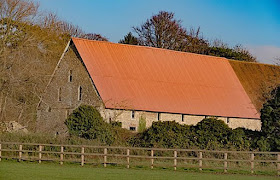by Toni Mount
The fully restored Boxley Abbey Barn is clearly visible as you drive by on the M20 and, originally, this wasn’t a barn but the hospitium, not a hospital but the building in which visitors were given hospitality, so more like a hotel.
 |
| Photo Credit: Toni Mount |
The abbey was founded in the mid-twelfth century but a few decades on, after Archbishop Thomas Becket was martyred in 1170, Boxley became a popular stopping point for pilgrims on their way from London to Canterbury to visit the saint’s shrine. The Abbot of Boxley had played a part in organising Becket’s funeral. In 1480, the time of Seb’s visit, the abbot was John Wormsell.
The abbot and his monks knew there was money to be made from the pilgrims and Boxley exploited the possibilities to the full. Pilgrims could stay overnight and receive food and drink and, in theory, this was free because giving hospitality to those making a journey in the name of God was a Christian virtue. However, donations were strenuously encouraged and for those without money, a day’s manual labour at the abbey would do instead. But Boxley’s monks were ingenious at inventing ways of generating extra income. They sold lead pilgrim badges as souvenirs of Boxley, depicting what long been known as the Rood of Grace.
Every medieval church had a Rood. This was a carved figure of Christ on the cross with the Virgin Mary and St John on either side of the dying Saviour. The Rood was placed high up on the Rood Screen which divided the nave of a church – where the ordinary congregation would be – from the chancel – where the priests conducted the service. The Rood was there to visibly remind everyone why they attended church. But Boxley’s Rood of Grace was no ordinary carving: it was miraculous.
The twelfth-century figure of Christ could turn and nod its head, move its eyes, shed tears, move its lips and speak which, of course, encouraged pilgrims to be even more generous with their donations. Legend said that the wondrous figure had been carved by a poor English carpenter taken prisoner by the French in order to pay his ransom. And how did it get to Boxley? Apparently, a stray horse brought it to the abbey though how the horse crossed the Channel nobody said – it was just an extra piece of the miracle.
And that wasn’t all. The pilgrims were also given the opportunity to demonstrate their personal piety by lifting the little swaddled figure of the infant St Rumbold from his plinth – only the truly pious would succeed.
Later, during the Reformation of the sixteenth century, Protestants denounced the Rood as fraudulent Roman Catholic superstitious nonsense. And it was a fraud as Geoffrey Chamber, Thomas Cromwell’s commissioner, who oversaw the dissolution of Boxley Abbey in 1538, discovered. When the Rood was taken down, its mechanism of levers, rods and wires was revealed: a marvel cleverly constructed by man but not a miracle of God. But when Geoffrey asked the abbot, John Dobbes, and the monks about it, they claimed ignorance, saying they knew nothing of these workings.
 |
| Photo Credit: Toni Mount |
Ruins of Boxley Abbey’s gateway The Rood was exhibited in Maidstone’s market place the same day, so everyone could know it was a fake, before being taken to London. There, outside St Paul’s Cathedral, the Bishop of Rochester – in whose diocese Boxley Abbey stood – publicly denounced the Rood as a piece of Roman Catholic fakery, designed to deceive the people and persuade them to give money to the monastery and, by extension, to the pope. The Rood was then chopped to pieces before being thrown on a bonfire along with other saintly and so-called ‘miraculous’ relics.
As for little St Rumbold, that was also a scam. Before attempting to lift the statue, a pilgrim had to make a donation. Only if the pilgrim was deemed to have been as generous as his purse allowed did the supervising monk release the bolt holding the statue in place. So the lifting of the saint wasn’t proof of righteousness, only of the monk’s decision that you’d given as much money as you could afford and no less.
The Colour of Sin by Toni Mount
In today's article, Toni Mount continues her online book tour with an article about Boxley Abbey in Kent.
In Toni Mount's latest Sebastian Foxley medieval murder mystery, The Colour of Sin, her hero goes on a pilgrimage to Canterbury. The pilgrim band spend a night at the Cistercian monastery at Boxley, just north of Maidstone in Kent, where a few ruins can still be seen today.
Toni Mount is the author of the award winning "Sebastian Foxley Medieval Murder Mystery Series". You can find out more about Toni on her website http://tonimount.co.uk

No comments:
Post a Comment
Note: Only a member of this blog may post a comment.